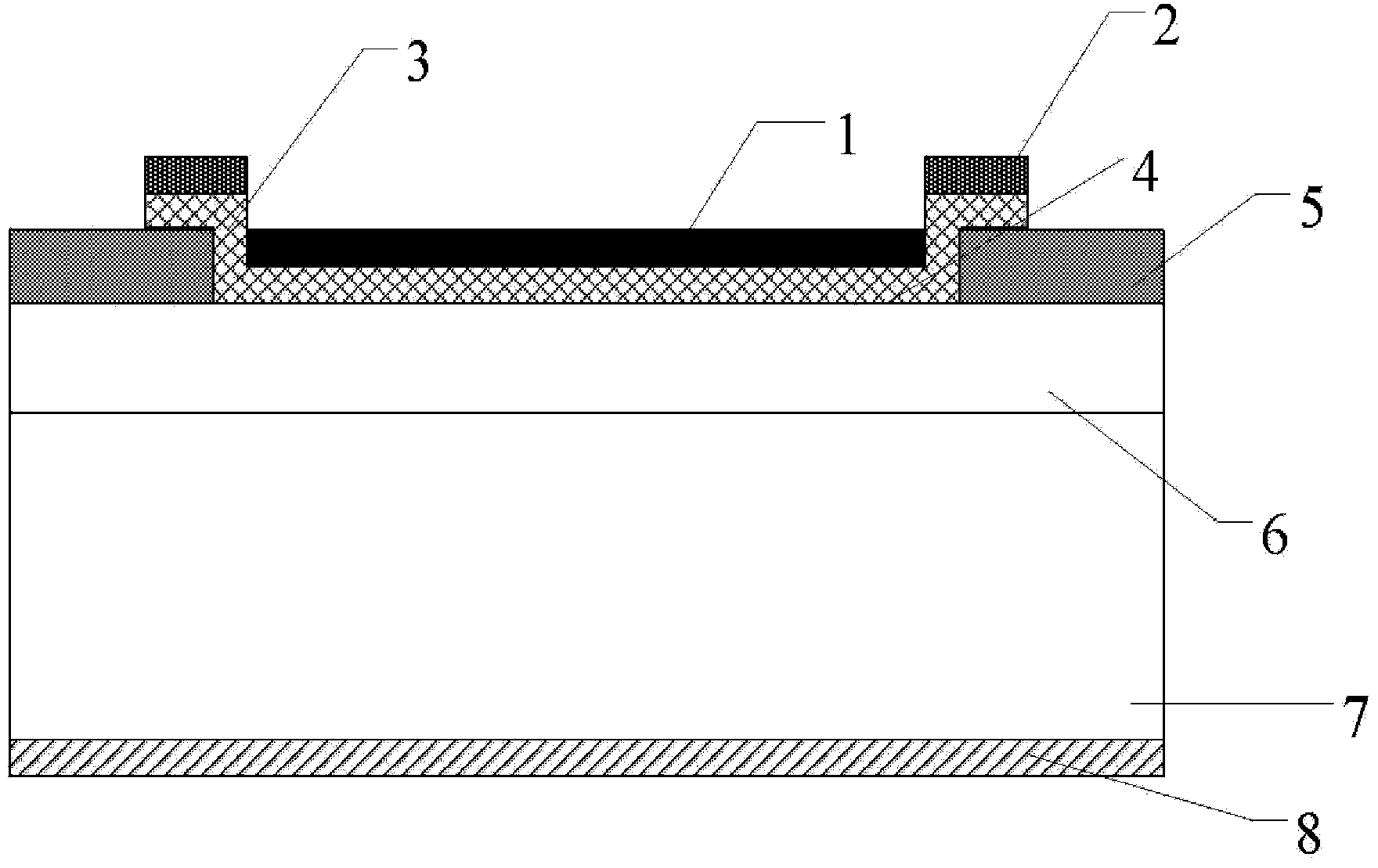Silicon carbide schottky junction type nuclear battery comprising niobium doped n-type epitaxial layer
A silicon carbide and nuclear battery technology, applied in the field of silicon carbide Schottky junction nuclear batteries, can solve the problems of large energy loss of incident particles, low energy conversion efficiency, etc., to increase the width of the depletion region, improve the collection rate, The effect of improving open circuit voltage and energy conversion efficiency
- Summary
- Abstract
- Description
- Claims
- Application Information
AI Technical Summary
Problems solved by technology
Method used
Image
Examples
Embodiment 1
[0024] Step 1, epitaxial n-type epitaxial layer on SiC highly doped n-type substrate sample.
[0025] The selected doping concentration is 1×10 18 cm -3 The highly doped n-type SiC substrate 7, after cleaning, is epitaxially grown on the highly doped n-type SiC substrate with a thickness of 4um and an initial n-type epitaxial layer doped with nitrogen ions, and its doping concentration is 1×10 15 cm -3 , the epitaxy temperature is 1570°C, the pressure is 100mbar, the reaction gases are silane and propane, the flow rates are 50sccm and 150sccm respectively, the carrier gas is pure hydrogen, and the impurity source is liquid nitrogen.
[0026] Step 2: For a nitrogen doping concentration of 1 x 10 15 cm -3 The initial n-type SiC epitaxial layer is implanted with niobium ions.
[0027] (2.1) The concentration of nitrogen doping is 1×10 15 cm -3 The initial n-type SiC epitaxial layer was implanted with niobium ions, and the conditions of the niobium ion implantation were: th...
Embodiment 2
[0043] Step 1: Epitaxial n-type epitaxial layer on SiC highly doped n-type substrate sample.
[0044] The selected doping concentration is 5×10 18 cm -3 The highly doped n-type SiC substrate 7, after cleaning, is epitaxially grown on the highly doped n-type SiC substrate with a thickness of 3um and an initial n-type epitaxial layer doped with nitrogen ions, and its doping concentration is 5×10 15 cm -3 , the epitaxy temperature is 1570°C, the pressure is 100mbar, the reaction gases are silane and propane, the flow rates are 50sccm and 150sccm respectively, the carrier gas is pure hydrogen, and the impurity source is liquid nitrogen.
[0045] Step 2: The concentration of nitrogen doping is 5×10 15 cm -3 The initial n-type SiC epitaxial layer is implanted with niobium ions.
[0046] (2.1) The concentration of nitrogen doping is 5×10 15 cm -3 The initial n-type SiC epitaxial layer was implanted with niobium ions, and the conditions of the niobium ion implantation were: the...
Embodiment 3
[0062] Step A: Epitaxial n-type epitaxial layer on SiC highly doped n-type substrate sample.
[0063] The selected doping concentration is 7×10 18 cm -3 The highly doped n-type SiC substrate 7, after cleaning, is epitaxially grown on the highly doped n-type SiC substrate with a thickness of 5um and an initial n-type epitaxial layer doped with nitrogen ions, and its doping concentration is 2×10 15 cm -3 , the epitaxy temperature is 1570°C, the pressure is 100mbar, the reaction gases are silane and propane, the flow rates are 50sccm and 150sccm respectively, the carrier gas is pure hydrogen, and the impurity source is liquid nitrogen.
[0064] Step B: For a nitrogen doping concentration of 2 x 10 15 cm -3 The initial n-type SiC epitaxial layer is implanted with niobium ions.
[0065] (B1) The concentration of nitrogen doping is 2×10 15 cm -3 The initial n-type SiC epitaxial layer was implanted with niobium ions, and the conditions of the niobium ion implantation were: the...
PUM
| Property | Measurement | Unit |
|---|---|---|
| Doping concentration | aaaaa | aaaaa |
| Thickness | aaaaa | aaaaa |
| Doping concentration | aaaaa | aaaaa |
Abstract
Description
Claims
Application Information
 Login to View More
Login to View More - R&D
- Intellectual Property
- Life Sciences
- Materials
- Tech Scout
- Unparalleled Data Quality
- Higher Quality Content
- 60% Fewer Hallucinations
Browse by: Latest US Patents, China's latest patents, Technical Efficacy Thesaurus, Application Domain, Technology Topic, Popular Technical Reports.
© 2025 PatSnap. All rights reserved.Legal|Privacy policy|Modern Slavery Act Transparency Statement|Sitemap|About US| Contact US: help@patsnap.com

